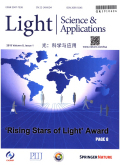- 钛学术文献服务平台 \
- 学术期刊 \
- 工业技术期刊 \
- 电工技术期刊 \
- 光:科学与应用(英文版)期刊 \
Spontaneously coherent orbital coupling of counterrotating exciton polaritons in annular perovskite microcavities
Spontaneously coherent orbital coupling of counterrotating exciton polaritons in annular perovskite microcavities
基本信息来源于合作网站,原文需代理用户跳转至来源网站获取
摘要:
Exciton-polariton condensation is regarded as a spontaneous macroscopic quantum phenomenon with phase ordering and collective coherence. By engineering artificial annular potential landscapes in halide perovskite semiconductor microcavities, we experimentally and theoretically demonstrate the room-temperature spontaneous formation of a coherent superposition of exciton-polariton orbital states with symmetric petal-shaped patterns in real space, resulting from symmetry breaking due to the anisotropic effective potential of the birefringent perovskite crystals. The lobenumbers of such petal-shaped polariton condensates can be precisely controlled by tuning the annular potential geometry. These petal-shaped condensates form in multiple orbital states, carrying locked alternatingπphase shifts and vortex–antivortex superposition cores, arising from the coupling of counterrotating exciton-polaritons in the confined circular waveguide. Our geometrically patterned microcavity exhibits promise for realizing room-temperature topological polaritonic devices and optical polaritonic switches based on periodic annular potentials.

推荐文章
Snowball Earth at low solar luminosity prevented by the ocean–atmosphere coupling
Faint Young Sun paradox
Carbon dioxide
Earth system
Siderite
An experimental study on dynamic coupling process of alkaline feldspar dissolution and secondary min
Alkaline feldspar
Dissolution rate
Precipitation
Mineral conversion
Secondary porosity
内容分析
关键词云
关键词热度
相关文献总数
(/次)
(/年)
文献信息
| 篇名 | Spontaneously coherent orbital coupling of counterrotating exciton polaritons in annular perovskite microcavities | ||
| 来源期刊 | 光:科学与应用(英文版) | 学科 | |
| 关键词 | |||
| 年,卷(期) | 2021,(3) | 所属期刊栏目 | Articles |
| 研究方向 | 页码范围 | 401-408 | |
| 页数 | 8页 | 分类号 | |
| 字数 | 语种 | 英文 | |
| DOI | |||
五维指标
引文网络
引文网络
二级参考文献 (0)
共引文献 (0)
参考文献 (34)
节点文献
引证文献 (0)
同被引文献 (0)
二级引证文献 (0)
1991(1)
- 参考文献(1)
- 二级参考文献(0)
2003(1)
- 参考文献(1)
- 二级参考文献(0)
2006(2)
- 参考文献(2)
- 二级参考文献(0)
2007(2)
- 参考文献(2)
- 二级参考文献(0)
2008(2)
- 参考文献(2)
- 二级参考文献(0)
2009(3)
- 参考文献(3)
- 二级参考文献(0)
2010(1)
- 参考文献(1)
- 二级参考文献(0)
2011(1)
- 参考文献(1)
- 二级参考文献(0)
2012(1)
- 参考文献(1)
- 二级参考文献(0)
2014(3)
- 参考文献(3)
- 二级参考文献(0)
2015(1)
- 参考文献(1)
- 二级参考文献(0)
2016(4)
- 参考文献(4)
- 二级参考文献(0)
2017(5)
- 参考文献(5)
- 二级参考文献(0)
2018(4)
- 参考文献(4)
- 二级参考文献(0)
2019(2)
- 参考文献(2)
- 二级参考文献(0)
2020(1)
- 参考文献(1)
- 二级参考文献(0)
2021(0)
- 参考文献(0)
- 二级参考文献(0)
- 引证文献(0)
- 二级引证文献(0)
引文网络交叉学科
相关学者/机构
期刊影响力
光:科学与应用(英文版)
主办单位:
中国科学院长春光学精密机械与物理研究所
出版周期:
双月刊
ISSN:
2095-5545
CN:
22-1404/O4
开本:
出版地:
吉林省长春市东南湖大路3888号
邮发代号:
创刊时间:
语种:
eng
出版文献量(篇)
762
总下载数(次)
0
总被引数(次)
112
期刊文献
相关文献
推荐文献
- 期刊分类
- 期刊(年)
- 期刊(期)
- 期刊推荐
一般工业技术
交通运输
军事科技
冶金工业
动力工程
化学工业
原子能技术
大学学报
建筑科学
无线电电子学与电信技术
机械与仪表工业
水利工程
环境科学与安全科学
电工技术
石油与天然气工业
矿业工程
自动化技术与计算机技术
航空航天
轻工业与手工业
金属学与金属工艺
光:科学与应用(英文版)2022
光:科学与应用(英文版)2021
光:科学与应用(英文版)2020
光:科学与应用(英文版)2019
光:科学与应用(英文版)2018
光:科学与应用(英文版)2017
光:科学与应用(英文版)2016
光:科学与应用(英文版)2021年第9期
光:科学与应用(英文版)2021年第8期
光:科学与应用(英文版)2021年第7期
光:科学与应用(英文版)2021年第6期
光:科学与应用(英文版)2021年第5期
光:科学与应用(英文版)2021年第4期
光:科学与应用(英文版)2021年第3期
光:科学与应用(英文版)2021年第2期
光:科学与应用(英文版)2021年第12期
光:科学与应用(英文版)2021年第11期
光:科学与应用(英文版)2021年第10期
光:科学与应用(英文版)2021年第1期

 免费查重
免费查重










